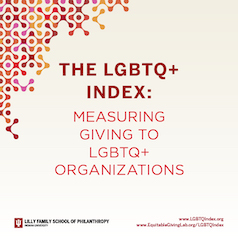Who is In My Community and What Do They Need?
Who is In My Community and What Do They Need?
by Andrew Whitehead, Associate Professor of Sociology, IU-Indianapolis, Co-Director of the Association of Religion Data Archives
Whenever I teach undergraduates, I try and remember how different their world is compared to when I grew up in the 1990s. A time before home internet where I was forced to consult our series of encyclopedias if I had a question.
Given most of my students were born after 9/11, things are quite different. We are now living in a time with an overabundance of information available to us at every moment. One quick Google search serves millions of possible answers.
This overabundance presents problems, though. We are left to consider which sources to trust, trying to determine if the algorithm has provided us with information or resources that contain the answers we need.
I’m guessing I’m not the only one who, when searching online for a product or service, is quickly overwhelmed by the tidal wave of information. Soon enough I’m closing my browser and feeling even more uncertainty than before.
In my work co-directing the Association of Religion Data Archives (ARDA), I consistently hear congregational leaders sharing similar stories—they have questions, they’re searching for answers, but sometimes it feels overwhelming to try and make sense of all the available information online and determine what or who to trust.
In the classroom I now try to equip my students to be better consumers of information, knowing where to go for answers and how to determine who or what is worth their time and trust.
In a similar vein, I’m continually excited to equip congregational leaders with religion data and resources they can trust through theARDA.com. These are just a few of the most-used resources that congregational leaders find helpful.
Congregational leaders and pastors use this resource to gain a data-driven sense of a given congregation’s context. This information helps them to know how best to serve their communities, as well as what types of ministries their congregations might start.
Consider the story of one Catholic priest who was introduced to the CPB during an ARDA workshop here in Indianapolis. He was involved in the Indianapolis Archdiocese’s education efforts and there were ongoing conversations around whether his diocese needed to offer languages other than English, and if so, which ones.
Some of the decision makers held assumptions—not based on any data—that the surrounding community members would be best served by offering Spanish. However, he was able to use the CPB to demonstrate that the diocesan schools’ assumptions around language needs were outdated. Many more folks from Southeast Asia were populating those communities. A focus on Southeast Asian immigrant Catholics was necessary.
Another local religious leader shared how initiating conversations with community partners can at times be difficult. Using the CPB, however, changed this narrative and being able to bring local demographic information to the table resourced these strategic discussions.
The consistent positive feedback we receive from congregational leaders using the CPB demonstrates how it resources people and groups coming from different perspectives to understand and communicate possibilities and challenges more clearly. This leads to more fruitful and generative conversations.
Beyond the CPB, there are several other resources on the ARDA that congregational leaders we work with find helpful.
The ARDA’s Religious Group Profiles offer data and information for thousands of religious groups operating in the United States. These profiles are a powerful way to quickly find answers to questions like, “How many Southern Baptists adherents are there in the US over past few the decades?” Or, “Which US counties have the most Catholics?” Or, “Where are the United Methodist Church congregations located in my community?” You can even view membership rate maps for every state.
The Religion Census resource provides membership reports for counties, metro areas, cities, and states over time or in present-day maps. Congregational leaders can quickly determine which groups in their counties or cities are growing, declining, or treading water. The Congregations tab on the ARDA homepage is another one-stop shop for resources useful to congregations.
In a time where there is so much information at our disposal, but little in the way of determining which information will be most helpful to congregational leaders, the ARDA exists to make high-quality and appropriate data easily accessible. And the best part? It’s all free.
 Andrew Whitehead is an Associate Professor of Sociology and Director of the Association of Religion Data Archives (theARDA.com) at the Center for the Study of Religion and American Culture at IUPUI.
Andrew Whitehead is an Associate Professor of Sociology and Director of the Association of Religion Data Archives (theARDA.com) at the Center for the Study of Religion and American Culture at IUPUI.
Whitehead is one of the foremost scholars of Christian nationalism in the United States. He is the author of American Idolatry: How Christian Nationalism Betrays the Gospel and Threatens the Church, which released August 2023 from Brazos Press. He is the lead author of Taking America Back for God: Christian Nationalism in the United States (Oxford University Press, 2020)—along with Samuel Perry—which won the 2021 Distinguished Book Award from the Society for the Scientific Study of Religion.
In recognition of these efforts, Whitehead was awarded the 2023 IUPUI Research Trailblazer Award and the 2023 Outstanding Tenure Track Faculty Award from the IUPUI School of Liberal Arts.
Expanded Perspective: Practical Steps
by Meredith McNabb
As Andrew Whitehead observes, there are all kinds of ways for congregational leaders to use the ARDA, which has a vast amount of data compiled. Here are some steps that Lake Institute has found helpful for beginners to ARDA who would like to use the data with an eye toward understanding their givers and potential givers:
- At the ARDA Community Profile Builder site, fill in your congregation’s address, and then zoom in or out to get a map radius that encompasses where most of your constituents live. Click on “Profile” to get the picture of your community.
- The “Income” report may be one of the first pieces to catch your attention when you’re thinking about the giving potential in your community, but it can also be very helpful to look at the “Housing” and “Employment” reports to get a fuller picture. Invite your leadership team to take a look at what rent is in your area, what the housing values trends look like, and how employment is changing. All of these economic factors matter to the giving picture in your community.
- Click through the other demographics that the ARDA captures—how does your congregation align with or diverge from your neighborhood in age, educational levels, family makeup, language, or race/ethnicity? Who are some of your archetypes of donors? (eg, senior adults living alone, families with preschool children, people whose rent is rising quickly, people who frequently change jobs, etc.)
- With this fuller picture of who you’re asking to participate through their giving, revisit your letters, brochures, website, or other fundraising campaign elements: do they resonate with the people you’re hoping they’ll reach? Which demographic groups or archetype donor voices aren’t a part of your leadership team—seek some of them out to get to know their experiences of your congregation and how they think about giving.
Facts are our friends—and the plural of anecdote is not data! The ARDA can help you identify fact-based trends and the lived realities of those in your community, so that you can serve and reach them most effectively.
New Research: The LGBTQ+ Index
 The LGBTQ+ Index is the sole comprehensive directory of charitable entities dedicated to supporting the LGBTQ+ community, providing insights into the realm of LGBTQ+ organizations.
The LGBTQ+ Index is the sole comprehensive directory of charitable entities dedicated to supporting the LGBTQ+ community, providing insights into the realm of LGBTQ+ organizations.
This new report, The LGBTQ+ Index Report 2024, provides empirical data that can help donors, nonprofits, practitioners and others kickstart action to generate more funding for LGBTQ+ organizations.
The Equitable Giving Lab brings an equity lens to philanthropy by measuring funding for under-resourced groups. It is part of the Indiana University Lilly School of Philanthropy at IU Indianapolis and is supported by Google.org.
Community Profile Builder
 This tool assists church and community leaders in accessing free online information about their communities. The initial map shows the location of other churches in your area and the Community Profile Builder provides you with social, economic, and religious information on the community or neighborhoods you select.
This tool assists church and community leaders in accessing free online information about their communities. The initial map shows the location of other churches in your area and the Community Profile Builder provides you with social, economic, and religious information on the community or neighborhoods you select.
The ARDA also offers in-depth guides that focus on a specific aspect of a community, like housing, education, or income. These guides offer more detailed directions for exploring all of the data the ARDA has on a specific aspect of community life.
Subscribe
Insights, a bi-weekly e-newsletter, is a resource for the religious community and fundraisers of faith-based organizations that provides:
- Reflections on important developments in the field of faith and giving
- Recommended books, studies and articles
- Upcoming Lake Institute events

